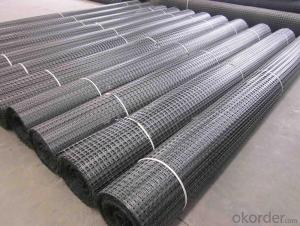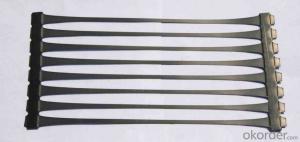Polymer Biaxial Geogrids for Civil Engineering Dikes
- Loading Port:
- China main port
- Payment Terms:
- TT OR LC
- Min Order Qty:
- 1000 m²
- Supply Capability:
- 10000000 m²/month
OKorder Service Pledge
OKorder Financial Service
You Might Also Like

Product Introduction
Type:
Geogrids
Place of Origin:
Jiangsu, China (Mainland)
Brand Name:
Lonrace
Model Number:
geogrid
Material:
Polyester
Color:
White Black Gray Etc
Tensile strength:
25Kn/m--300Kn/m
Length:
50-100m
Certification:
CE /ISO9001
Coating:
PVC
Production function
1.It can be applied in all kinds of roads,airports to enhance the roadbed;
2.It can be applied in a large car park and terminal freight yard,etc. to strengthen the foundations of a permanent load;
3.It can be applied in rail, road slope's protection;
4.It can be applied to enhance the culvert;
5.It can be applied as a secondary enhancement after the uniaxial Geogrid soil Our Service
Quality assurance
1.On a regular basis or as per your request,we entrust national testing agencies to conduct quality inspections
2. Strictly in accordance with the ISO9001-2008 international quality system standard,we monitor and manage the whole process throughout production,quality testing,and measurement to ensure product quality
3. For quality-related construction delay or substandard construction(except for damage or losses due to customer’s responsibility or irresistible natural disasters),we have refunding,replacement,and repair services.We will respond to customers’ feedbacks on quality issues within 24 hours.
Packaging & Shipping
Packing: PLASTIC FILM INSIDE, AND WOVEN BAG OUTSIDE
Shipping: About 15 days after receipt the deposit
FAQ:
Q: What kind of payments does jenor support?
A: T/T, L/C, Cash are accepted.
Q: Do you charge for the samples?
A: Accordeing to our company policy, the samples are free, we only charge the freight fee. And we will return the freight fee during the next order.
Q: Can you produce according to customers' design?
A: Sure, we are professional manufacturer, OEM and ODM are both welcome.
Q: Do you have other products?
A: Yes, please check the pictures:
- Q: Are geogrids suitable for use in permafrost conditions?
- Geogrids are generally not suitable for use in permafrost conditions due to their potential to cause ground disturbance and accelerate thawing of the frozen soil. Permafrost is a delicate and sensitive environment, and any disturbance to its structure can lead to significant damage and instability. Therefore, alternative solutions specifically designed for permafrost conditions should be considered to ensure long-term stability and environmental protection.
- Q: What are the factors that affect the design of geogrid-reinforced structures?
- The factors that affect the design of geogrid-reinforced structures include the type and strength of geogrid material, soil properties (such as strength and settlement characteristics), loading conditions, design life requirements, construction techniques, and potential environmental factors (such as temperature variations and chemical exposure). Additionally, factors such as site-specific conditions, project constraints, and regulatory requirements may also influence the design of geogrid-reinforced structures. Overall, a comprehensive understanding of these factors is crucial to ensure the optimal design and performance of geogrid-reinforced structures.
- Q: How do geogrids enhance the performance of geotextile tubes?
- Geogrids enhance the performance of geotextile tubes by providing additional strength, stability, and reinforcement to the structure. They help distribute and transfer the loads more efficiently, improving the overall stability and resistance to deformation of the geotextile tubes.
- Q: Polypropylene geogrid
- You said the polypropylene geogrid, generally only two-way plastic geogrid and one-way plastic geogrid is polypropylene material
- Q: How do geogrids enhance the stability of embankments?
- Geogrids enhance the stability of embankments by providing reinforcement and structural integrity. They are installed within the soil layers of the embankment to distribute the applied loads and increase the overall strength of the structure. Geogrids also help to prevent soil erosion and lateral movement, reducing the risk of slope failures and improving the long-term stability of the embankment.
- Q: What are the durability characteristics of geogrids?
- Geogrids are known for their high durability characteristics. They are typically designed to withstand heavy loads, harsh environmental conditions, and long-term exposure to various elements. Geogrids are made from strong materials such as polyester or polypropylene, which provide excellent tensile strength and resistance against stretching or deformation. Additionally, they have good chemical resistance, making them suitable for use in different soil types and corrosive environments. Overall, geogrids offer long-lasting performance and can provide reliable reinforcement and stabilization for various civil engineering applications.
- Q: How to fill in the geogrid evaluation form
- According to the test items of evaluation evaluation standard above
- Q: Which kind of polypropylene geogrid belongs to the geogrid?,Geogrid is divided into four categories: plastic geogrid, steel plastic geogrid, fiberglass geogrid and fiberglass polyester geogridPlastic geogrid?
- Which kind of geogrid belongs to geogrid?Plastics geogrids divided tgsg and geogrid, geogrid and unidirectional polypropylene geogrid and unidirectional polyethylene geogrid, tgsg material is polypropylene;
- Q: I would like to ask what kind of railway construction materials?Under the trouble of experts who can help me explain these materials. I am engaged in the procurement of Railways in this regard, I want to rush to prepare the information
- Plate Q235-A Delta =0.5 ~ 6Plate Q235-A Delta =7 ~ 40Plate 16Mnq Delta =6 ~ 10
- Q: What is the effect of temperature on geogrid properties?
- The effect of temperature on geogrid properties can vary depending on the specific material and design of the geogrid. In general, higher temperatures can cause the geogrid to expand and become more flexible, which can result in increased tensile strength and improved load-bearing capacity. However, extreme temperatures, either high or low, can also lead to a decrease in geogrid properties, such as reduced stiffness and reduced resistance to deformation. Therefore, it is important to consider the temperature conditions in which the geogrid will be used to ensure optimal performance and longevity.
Send your message to us
Polymer Biaxial Geogrids for Civil Engineering Dikes
- Loading Port:
- China main port
- Payment Terms:
- TT OR LC
- Min Order Qty:
- 1000 m²
- Supply Capability:
- 10000000 m²/month
OKorder Service Pledge
OKorder Financial Service
Similar products
Hot products
Hot Searches
Related keywords
































